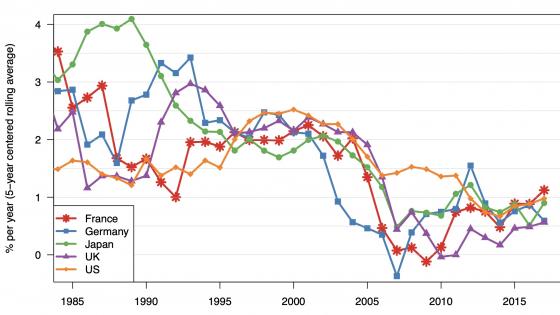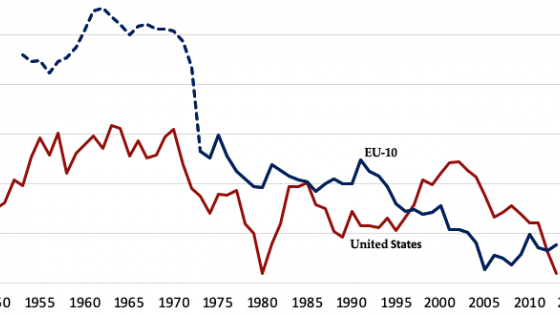Debates about the economic policy response to stagnating productivity growth in advanced economies start with identifying the proximate causes of the slowdown, which is no easy task, and targeting policy to those causes. Sayed and Gordon (2019) argue that “decelerating technical change, rather than slowing investment, was the primary driving force in the transatlantic slowdown”. Winkler et al. (2021) conclude that technological change “remains a key factor behind current macroeconomic trends and underpins the observed slowdown through various dimensions,” with additional contributions from slower growth of capital per worker, slower growth of global trade and changes in “allocative efficiency”. At the policy level, the 2024 Economic Report of the President of the United States (Council of Economic Advisors, 2024) contains 126 mentions of the word “productivity”. Chapter 7 of the report is entirely devoted to artificial intelligence, discussing economic and regulatory policy to measure, evaluate, and manage the emerging technology.
In this column, we focus on technological change via the lens of total factor productivity (TFP) growth, which was identified as a key measure of innovation by the U.S. Department of Commerce (Advisory Committee on Measuring Innovation in the 21st Century Economy, 2008). We have developed a detailed cross-country dataset to measure the industry sources of economic growth in the US and Japan using 'modern growth accounting’ (Inklaar et al. 2022).
These accounts carefully define comprehensive outputs and inputs in constant quality (or composition-adjusted) units that are matched to appropriate price deflators (e.g. including land inputs, imputing consumer durable capital services, using quality adjusted prices for computers and other high-tech devices). Mismeasurement is a serious concern in growth accounting, as discussed by Winkler et al. (2021), but the dataset that we have developed incorporates the most detailed and comprehensive data that we are aware of.
Here, we summarise two conclusions about technological change over the 1955-2019 period reported in our recent paper (Ho et al. 2023). Our first finding is that the slowdown in productivity growth in the computer sector explains a significant portion of the aggregate productivity slowdowns in both countries. The ‘computer’ sector contains many of the high-tech devices that drive investment in information and communications technology (ICT), including computer and peripheral equipment manufacturing, communications equipment manufacturing, and semiconductor manufacturing.
Figure 1 shows the contribution of productivity growth in the computer sector to aggregate TFP growth in the US and Japan (this is the ‘standard’ contribution and is essentially the Domar weight multiplied by TFP growth in each industry). The horizontal dotted lines represent the averages over sub-periods. The peak contribution was during 1995-2004 in both countries and there is a very clear step-down pattern in the contribution of TFP growth in the computer sector since then. Towards the end of this period, the contribution of the computer sector resembled the levels before the late 1960s, when Moore’s Law took hold. Between the 1995-2004 and 2004-2019 sub-periods, aggregate TFP growth decelerated by 0.52 percentage points in the US, more than half of which (0.30 percentage points) is accounted for by the slowdown in productivity in the computer sector. In Japan, aggregate TFP growth decelerated by 0.22 percentage points over the same period, more than accounted for by the 0.27 percentage point slowdown in the contribution of productivity growth in the computer sector. Note that the computer sector is a small sector in both countries, with its share of total value-added never exceeding 2.3% in either country. While the notion that the deceleration in ICT TFP is important is not new to productivity studies, the magnitudes that we measure – and the methods that we use that are consistent with the framework of the national accounts – provide strong evidence of the disproportionate importance of the production of ICT to productivity growth in advanced economies.
Figure 1 Contribution of TFP growth of the computer sector to aggregate TFP growth
Note: The contribution is defined as the Domar-weighted industry TFP growth rate.
Our second conclusion is new and concerns how TFP growth affects the cost of capital, and thus the price of aggregate output. The ‘cost of capital’ mechanism is intuitive: productivity growth in ICT drives down the price of investment in ICT, and thus the cost of capital of any sector that invests in ICT. Since use of ICT capital has been growing steadily over time, this effect has also been growing over time and counterbalances some of the deceleration in the direct contribution of TFP growth in ICT to aggregate TFP growth shown in Figure 1. (The magnitude of this ‘cost of capital’ effect involves the TFP growth rate in ICT, the weight of ICT in the capital input of each sector, and the share of capital input in total inputs.) Figure 2 shows the economy-wide impact of this ‘cost of capital’ mechanism relative to the standard contributions of computer TFP: the sub-period averages of this ratio rise over time in both countries. The key conclusion is that this effect has been growing in importance since the mid 1990s, coinciding with the increasing adoption of ICT following the acceleration of semiconductor technology growth and the resultant rapid fall in ICT prices (Jorgensen 2001). In broad terms, ongoing technological progress in the computer sector has made using ICT capital in production cheaper, and this falling cost has allowed producers across all industries to charge lower prices for their goods and services.
Figure 2 Contribution of the cost-of-capital effect relative to the direct TFP effect of ICT on aggregate TFP
Our two findings reinforce the need to pay close attention to developments in the ICT-producing sectors when analysing the sources of aggregate economic growth. On one hand, productivity in these sectors is of disproportionate importance to aggregate productivity growth in advanced economies. On the other hand, these innovations carry over to industries that make use of computing technology. While the former has decelerated, the latter has accelerated since the mid-1990s. Importantly, the use of ICT technology is much more widespread across industries and countries than its production, so that aggregate economic gains from ICT adoption across the world economy may soon (or may already) outpace the standard measured contribution of ICT productivity to aggregate productivity growth.
The relationship between emerging technologies and measured productivity growth is of keen interest to those studying the sources of, and prospects for, economic growth. For example, there are discussions of how general-purpose technologies require complementary investments and new processes and thus may lead to a productivity J-curve (Brynjolfsson et al. 2021). Irrespective of whether or not we will observe a large, delayed response for productivity, we have demonstrated that the impact of existing technologies is significantly broader than previously identified.
Authors’ note: The views expressed in this column are solely those of the authors and not necessarily those of the U.S. Bureau of Economic Analysis (BEA) or the U.S. Department of Commerce.
References
Advisory Committee on Measuring Innovation in the 21st Century Economy (2008), Innovation Measurement: Tracking the State of the Innovation in the American Economy.
Brynjolfsson, E, D Rock and C Syverson (2021), “The Productivity J-Curve: How Intangibles Complement General Purpose Technologies”, American Economic Journal: Macroeconomics 13(1): 333-72.
Council of Economic Advisors (2024), Economic Report of the President, 21 March.
Ho, M S, K Nomura and J D Samuels (2023), “The Growing Impact of ICT Productivity via the Cost of Capital: Evidence from the U.S. and Japan”, Telecommunications Policy 47(9).
Inklaar, R, B Van Ark and J Fernald (2022), “Dale Jorgenson: Investment, Growth Accounting, and Economic Measurement”, VoxEU.org, 24 June.
Jorgenson, D W (2001), “Information Technology and the U.S. Economy”, American Economic Review 91(1).
Sayed, H and R J Gordon (2019), “The Industry Anatomy of the Transatlantic Productivity Growth Slowdown: Similarities Outweigh the Differences”, VoxEU.org, 29 August.
Winkler, J, P Koutroumpis, F Lafond and I Goldin (2021), “Re-evaluating the Sources of the Recent Productivity Slowdown”, VoxEU.org, 31 May.








